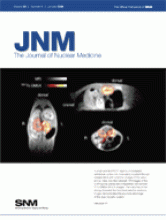TO THE EDITOR: We refer to the recent Invited Perspective which proposes that there is now a reduced role for V/Q scintigraphy in the detection of pulmonary embolism (PE) given the emergence of CT pulmonary angiography (CTPA) (1). Although the article addressed many of the strengths and limitations of CTPA in the evaluation of suspected PE, we do not agree with the suggestion that there is now a role for ventilation/perfusion (V/Q) scanning only in a very limited number of patient groups. It is surprising that this review article makes no mention of the use of V/Q SPECT, which has been shown to be superior to planar V/Q scintigraphy (2,3) and CTPA (2). As with other areas of nuclear medicine, the transition from planar techniques to SPECT has led to improvements in sensitivity and diagnostic accuracy. The published literature on V/Q SPECT has consistently shown improvements in sensitivity (2,3), specificity (3,4), and intraobserver reproducibility (2–4), as well as reducing the number of intermediate or inconclusive results to less than 5% (3,5). In a direct comparison of CTPA and V/Q SPECT in 83 patients with suspected PE, Reinartz et al. demonstrated a sensitivity of 97% for SPECT, compared with 86% for CTPA (2). The CTPA sensitivity in that paper is consistent with the 83% result quoted in the recent prospective multicenter PIOPED 2 study (6). These publications suggest that, even with current-generation CT technology, CTPA fails to diagnose PE in approximately 1 in every 6 patients. Given this failure rate, we consider that few clinicians would agree with Dr. Strashun in his statement that CTPA is “very sensitive” in the diagnosis of PE (1). As he correctly states, PE is a potentially fatal condition and its accurate diagnosis is essential. The limitations of CTPA in the detection of smaller emboli (particularly at the segmental and subsegmental levels) are well recognized (7); however, larger emboli can also be missed (6). Although it has been suggested that emboli not detected by CTPA are not clinically significant, this may not be the case in patients with cardiorespiratory disease (7), and in these patients in particular, accurate detection is crucial. Furthermore, the PIOPED 2 study demonstrated that the CTPA accuracy deteriorates further if the scan results do not correlate with the clinical likelihood of disease, and in these circumstances, the incidence of false-positive and false-negative results is significant (6). In this paper, 40% of negative CTPA results were false-negative if the clinical suspicion was high, and 42% of positive scan results were false-positive if the clinical suspicion was low. Dr. Strashun states that radiation dose and the risks of contrast media are the only 2 reasons why V/Q scintigraphy should be used in preference to CTPA (1). We would suggest the suboptimal sensitivity of CTPA is another reason why V/Q scintigraphy (using SPECT) should be used preferentially in most patients. V/Q SPECT using Technegas also has the advantage of an extremely high negative predictive value, reaching 98.5% in a large prospective series (5).
As Dr. Strashun states, there are other limitations with CTPA, including a significant number of technically suboptimal studies (6% in PIOPED 2), high breast radiation exposure (a particular concern in premenopausal women), and contrast-related side effects, such as allergy and renal impairment (1). None of these limitations apply to V/Q SPECT scintigraphy. It should also be noted that in the PIOPED 2 study, over 40% of patients did not undergo CTPA because of renal impairment, contrast allergy, or too poor a state of health (6). This hardly endorses the notion that CTPA should be regarded as the primary screening test for the imaging of PE. Although CTPA has the advantage of being able to detect other lung diseases, it should be noted that V/Q scintigraphy can detect conditions other than PE (8). It is also important to determine whether the other findings detected by CTPA are actually the cause of the patient's clinical symptoms, rather than being ancillary and unrelated. In such cases, the ability of CTPA to detect other diseases may be at the expense of a lower overall sensitivity in the detection of PE. Although there is no doubt that referring clinicians would like a diagnostic imaging test for PE that is highly sensitive and specific for disease detection, as well as being perfectly safe, it is apparent from the PIOPED 2 study that CTPA does not meet these criteria. It is important that referring clinicians understand the limitations of the technology (particularly in relation to sensitivity), despite the appeal that the binary reporting of CTPA may have.
It is unfortunate that V/Q scintigraphy in the United States continues to be done almost universally with planar imaging, and using 133Xe as the ventilation agent in many cases. As long as V/Q scintigraphy is performed in the same way that it was in the 1970s and 1980s, it is evident that the test will struggle to compete with the rapidly evolving CT technology. V/Q SPECT can be adequately performed with diethylenetriaminepentaacetic acid aerosols, and in many European countries as well as Canada and Australia, superior ventilation agents (such as Technegas) are available. V/Q SPECT is clearly superior to planar imaging and, combined with recent developments in computing and camera hardware, has the potential to be further enhanced with quantification and fusion imaging (9). In addition to its diagnostic role, V/Q SPECT has the ability to quantify the extent of PE, and this may be valuable in guiding treatment decisions (10). For all these reasons, it is disappointing that the Invited Perspective downplays the role of V/Q scintigraphy and completely ignores the advances that have occurred with the technique in regions where SPECT has long replaced planar V/Q scintigraphy.
Footnotes
-
COPYRIGHT © 2008 by the Society of Nuclear Medicine, Inc.







